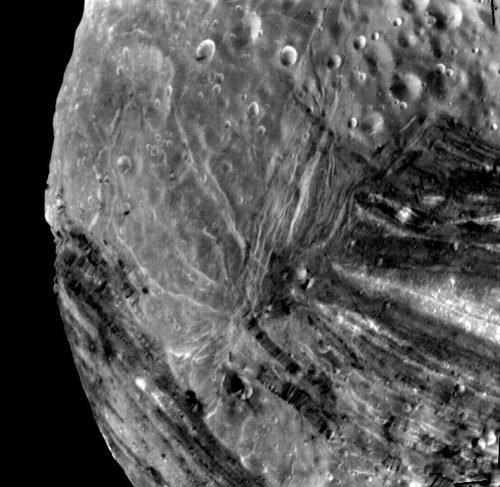Miranda’s fractures, grooves and craters; Image credit: NASA
There are many oddballs among the Solar System moons. But Miranda, the innermost moon of Uranus, stands out even from the ‘’weird bunch”. Everything from its bizarre scarred surface and unusual orbit to the possible existence of ice volcanoes causes raised eyebrows as well as much excitement among astronomers. Here are five weird but fascinating facts about this little explored world you probably didn’t know!
FACT 1: MIRANDA LOOKS LIKE A SCRUNCHED-UP BALL
The surface of Miranda looks like somebody has assembled the moon in a rush. Its deep fractures, giant craters, massive canyons and bizarre 200 kilometers wide ‘racetrack’ structures are among some of the weirdest features you can find anywhere in the Solar System. No wonder many people call Miranda ‘Frankenstein moon’!
Miranda is also home to the highest cliff in the Solar System – Verona Rupes – which is estimated to be 12 miles (20 kilometers) high. To compare, the tallest cliff on planet Earth is located on Mount Thor in Canada – with a vertical drop of about 1200 meters. How did this deformed landscape come into existence? Was the moon bombarded by meteorites? Survived a giant collision? Is this the result of stretching and squeezing caused by Uranus’ gravity? We don’t yet know!
📖 For more information on the topic check out
- images of Miranda taken by Voyager-2 spacecraft in 1986
FACT 2: MIRANDA’S NAME BROKE SOME ‘NAMING RULES’
Uranus has 27 moons, of which five – Miranda, Ariel, Umbriel, Titania and Oberon – are the largest, or, as we call them, ‘major’ moons. Miranda, the smallest of the five and the closest one to Uranus, was the last major moon to be discovered from Earth. It’s discoverer Gerard Kuiper called the moon Miranda after the character from Shakespeare’s The Tempest. The names of the 4 other Uranian moons known at the time were unconventional enough. For they were not the ‘usual’ names of the Greek or Roman gods and goddesses, but of the mythical characters from the plays of William Shakespeare and Alexander Pope. (Thanks for that, John Hershel!) But Kepler went even further and introduced a human character, Miranda, into Uranus’s realm. Interestingly enough, astronomers decided to keep up this tradition. Later they named many other Uranus’s moons after the mortal heroes from Shakespeare’s and Pope’s stories.
📖 For more information on the topic listen to the podcast
FACT 3: MIRANDA’S ORBIT IS TILTED (THOUGH IT SHOULDN’T BE!)
The orbits of the major moons of Uranus are positioned at the same angle. All…with the exception of Miranda. Ariel, Umbriel, Titania and Oberon circle around Uranus’s equator. But Miranda’s orbit is tilted at 4.3 degrees. To you and me a 4.3 degree angle may not sound much. But for a small moon located so close to its parent planet this is an unusually high and hard to explain tilt. How did Miranda’s orbit get so inclined? Probably it has to do with the gravitational interaction between the Uranian moons in the past, though astronomers are still working on the details!
📖 For more information on the topic go to
FACT 4: MIRANDA MIGHT HAVE ICE VOLCANOES
Miranda, just like the rest of the major moons of Uranus, is composed of approximately equal amounts of rock and water ice (with some other stuff, like ammonia and methane, mixed in). There is evidence (thank you, Voyager 2!) that the interiors of Miranda might have been liquid in the past. Moreover, some of this subsurface water might still remain unfrozen today and occasionally make its way to the frozen surface – all thanks to the eruptions of Miranda’s ice volcanoes!
📖 For more information on the topic read
FACT 5: MIRANDA’S SEASONS ARE EXTREME
The whole Uranian system is tipped on its side. Therefore Miranda shares the extreme seasonal pattern of its parent planet Uranus. What is a year on Uranus like? Well…a Uranian year lasts approximately 84 Earth years and has four seasons, each 21 year long. The Summer side of Uranus experiences continuous daylight, whereas the Winter side always remains in the dark. Autumn and Spring seasons are much more pleasant with day-and-night cycles repeating once a day. Not the best holiday destination, don’t you think?
📖 For more in-depth information read
If you enjoyed this post, why not learn more about other amazing Solar System moons, such as Saturn’s moon Enceladus and Jupiter’s moon Europa! You can also ‘visit’ these moons as part of our immersive presenter-led Portable Planetarium space show. For more details on who we are, what shows we offer and how to book a Star Dome please visit our website wonderdome.co.uk.


